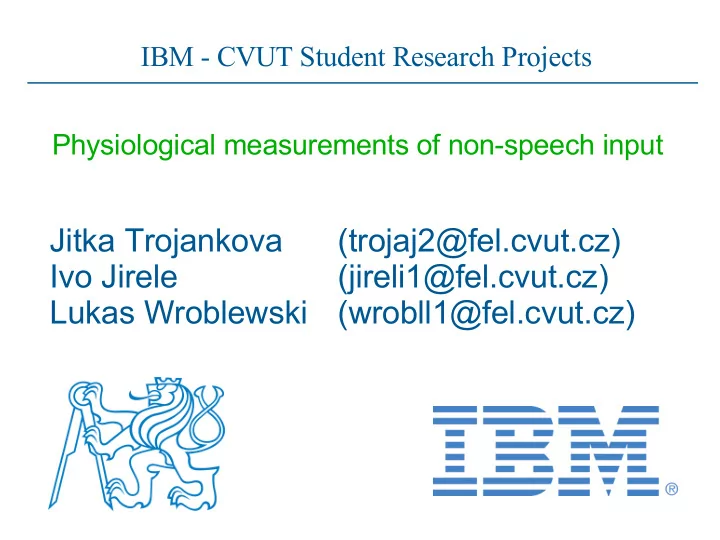

IBM - CVUT Student Research Projects Physiological measurements of non-speech input Jitka Trojankova (trojaj2@fel.cvut.cz) Ivo Jirele (jireli1@fel.cvut.cz) Lukas Wroblewski (wrobll1@fel.cvut.cz)
Goal • Quantify the ability of users to “aim” the pitch of tone they produce • Non-speech input as an addition to voice recognition for faster response – Realtime applications, games, etc. • Existing prototypes but quantification research has not been done yet IBM - CVUT Student Research Projects 2
Research Questions • Range Measurement – What is typical range of pitch that users can produce and use? • Tone Released Within Given Interval – How many different pitches can be recognized? • Speed of Re-intonation – How quickly can users slide from one pitch to another? IBM - CVUT Student Research Projects 3
Number of Pitches? problem wanted signal produced signal pitch time IBM - CVUT Student Research Projects 4
Conditions • Different ages and genders of participants • 25 participants, average age 30 years, standard deviation 15 years • 20 - 40 minutes per person • Input through humming (“mmm...”) • Recording for later analysis IBM - CVUT Student Research Projects 5
Range Measurement comfortable range width roughness of range borders 100 30 27,5 90 25 80 22,5 percent of people percent of people 70 20 60 17,5 50 15 12,5 40 10 30 7,5 20 5 10 2,5 0 0 <10 10—13 14—17 18—21 >21 2 4 6 8 10 >10 users' range in halftones range in halftones IBM - CVUT Student Research Projects 6
Tone Released within an Interval success in targetting specific interval width distance from interval when failed 100 100 90 90 percent of failed tasks 80 80 percent of success 70 70 60 60 50 50 40 40 30 30 20 20 10 10 0 0 <5 5—10 10—15 >15 1 2 4 8 distance in halftones width of target interval in halftones • From range=12 and width=4, we get 3 recognizable pitches IBM - CVUT Student Research Projects 7
Speed of Re-intonation time needed to slide into interval 8 halftones wide time needed to slide into interval 4 halftones wide 1000 1000 950 950 900 900 850 850 800 800 750 750 700 700 650 650 600 600 time [ms] time [ms] 550 550 500 500 450 450 400 400 350 350 300 300 250 250 200 200 150 150 100 100 50 50 0 0 6 8 12 8 10 14 distance of target interval in halftones distance of target interval in halftones IBM - CVUT Student Research Projects 8
Speed of Re-intonation time needed to slide into interval 2 halftones wide time needed to slide into interval 1 halftone wide 1800 1400 1700 1300 1600 1200 1500 1100 1400 1300 1000 1200 900 1100 800 1000 time [ms] time [ms] 900 700 800 600 700 500 600 400 500 400 300 300 200 200 100 100 0 0 4 - 5 6 - 7 10 - 11 5 7 11 distance of target interval in halftones distance of target interval in halftones IBM - CVUT Student Research Projects 9
Research Answers • Typical users' range they can produce and use is an octave • There are 3 pitches that can be safely recognized • Sliding from one pitch to another takes about 1 to 2 seconds, depending on distance and width of target interval IBM - CVUT Student Research Projects 10
Recommend
More recommend